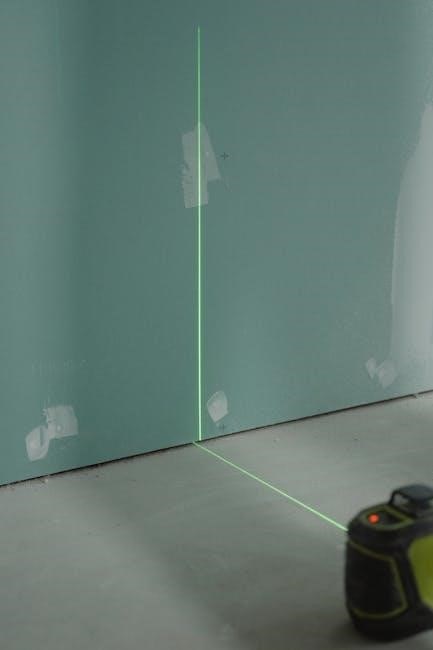
The Rogue is a versatile and cunning class‚ excelling in stealth‚ deception‚ and precision. They rely on Dexterity and Intelligence to outwit foes and bypass obstacles.
With a focus on agility and wit‚ Rogues are adept at navigating shadows‚ disarming traps‚ and delivering devastating sneak attacks. Their adaptability makes them invaluable in any party.
Whether as a stealthy assassin‚ a charming swashbuckler‚ or a resourceful scout‚ the Rogue offers endless possibilities for creative gameplay and strategic thinking in Pathfinder.
This guide explores the Rogue’s core mechanics‚ archetypes‚ combat tactics‚ and roleplaying opportunities‚ helping you craft a memorable and effective character.
Overview of the Rogue’s Role in a Party
The Rogue is a versatile and indispensable class in any Pathfinder party‚ offering a mix of combat‚ utility‚ and social expertise. They excel at dealing precision damage‚ disabling traps‚ and providing critical skills like Stealth‚ Perception‚ and Sleight of Hand.
As a striker‚ the Rogue shines in combat by exploiting enemy vulnerabilities through sneak attacks. They also act as a scout‚ identifying hazards and gathering information‚ and as a face‚ using charisma to manipulate or deceive foes.
Their adaptability makes them a valuable asset in both combat and exploration. Whether infiltrating‚ ambushing‚ or negotiating‚ the Rogue’s cunning and versatility ensure they contribute meaningfully to the party’s success in any situation.
Key Characteristics and Abilities
The Rogue is a master of shadows‚ deception‚ and precision‚ relying on Dexterity and Intelligence to excel in various roles. Their key ability is Sneak Attack‚ dealing bonus damage when attacking from stealth or with an ally flanking the target.
Rogues also possess Trapfinding‚ allowing them to detect and disarm traps with ease. They excel in skills like Stealth‚ Sleight of Hand‚ and Perception‚ making them adept at avoiding danger and uncovering hidden secrets.
With access to a wide range of skills‚ Rogues are highly adaptable‚ capable of excelling in both combat and social situations. Their charm‚ wit‚ and agility make them a versatile and essential class in any Pathfinder party.
Why Play a Rogue?
Playing a Rogue offers a unique blend of stealth‚ strategy‚ and versatility. They excel in both combat and non-combat scenarios‚ making them a dynamic addition to any party.
Rogues provide opportunities for creative problem-solving‚ whether it’s bypassing traps‚ outwitting enemies‚ or negotiating with NPCs. Their Sneak Attack ability adds excitement with critical hits that can turn the tide of battle.
With a wide range of archetypes‚ from the cunning Thief to the charismatic Swashbuckler‚ the Rogue class allows for diverse character builds and playstyles. This flexibility makes them appealing to players who enjoy adaptability and strategic thinking.
Core Class Features
Rogues excel with Sneak Attack‚ offering precision damage‚ and Trapfinding‚ which enables them to detect and disarm hazards. These abilities make them versatile and powerful in both combat and exploration.
Sneak Attack: Mechanics and Usage
Sneak Attack is the Rogue’s hallmark ability‚ allowing them to deal bonus damage when attacking a flanked or unaware enemy. It requires a weapon with finesse or ranged combat‚ ensuring precision and stealth.
Optimizing Sneak Attack involves positioning‚ using allies to flank‚ and catching enemies off guard. High Dexterity and accurate weapons amplify its effectiveness‚ making it a cornerstone of Rogue combat strategy.
Mastering Sneak Attack enhances the Rogue’s role as a striker‚ capable of delivering decisive blows in critical moments. Proper setup maximizes its impact‚ showcasing the Rogue’s deadly finesse and tactical brilliance in Pathfinder.
Skills: Essential and Utility Skills for Rogues
Rogues excel through their mastery of skills‚ which define their versatility and cunning. Essential skills like Stealth‚ Sleight of Hand‚ and Perception are critical for sneaking‚ manipulating objects‚ and detecting hidden threats or traps.
Bluff‚ Diplomacy‚ and Intimidate serve as utility skills‚ allowing Rogues to influence NPCs‚ negotiate‚ or demoralize enemies. These skills enhance their role as the party’s Face or strategic manipulator.
Investing in these skills maximizes the Rogue’s impact‚ enabling them to outwit foes‚ avoid danger‚ and solve challenges creatively. Skill mastery is central to the Rogue’s identity and effectiveness in Pathfinder.
Trapfinding: Identifying and Disabling Traps
Trapfinding is a cornerstone of the Rogue’s utility‚ allowing them to detect and neutralize hazards that threaten the party. This ability relies on a high Perception score and skill in Disable Device.
Rogues can identify traps through careful examination‚ often spotting hidden mechanisms or triggers. Once identified‚ they can use their expertise to disable these threats‚ ensuring safe passage for allies.
Trapfinding is invaluable in dungeons and exploration-heavy campaigns‚ making the Rogue an indispensable asset. It complements their stealth and cunning‚ showcasing their role as problem solvers and guardians.
This skill not only enhances survival but also underscores the Rogue’s versatility‚ turning potential dangers into manageable challenges.

Archetypes for Rogues
Archetypes like the Thief‚ Scout‚ and Swashbuckler redefine the Rogue’s role‚ offering unique playstyles; They specialize in stealth‚ ranged combat‚ or flair‚ giving players diverse customization options.
Thief: Mastering Stealth and Deception
The Thief archetype is a master of shadows and deception‚ excelling at stealth and cunning. They gain expertise in Sleight of Hand and Stealth‚ allowing them to move undetected and pilfer items with ease.
Key abilities include Fast Stealth‚ which lets them move without penalty while hiding‚ and Trap Sense‚ enhancing their reflexes to avoid hazards. Thieves also gain access to Major Magic‚ granting them limited use of spells like Invisibility for strategic advantages.
With a focus on agility and charisma‚ Thieves are perfect for players who enjoy outsmarting foes and manipulating situations. Their versatility makes them ideal for both combat and social encounters in Pathfinder.
By leveraging their skills and abilities‚ Thieves can become the backbone of any party‚ ensuring missions are executed with precision and flair.
Scout: excelling at Ranged Combat and Exploration
The Scout archetype transforms the Rogue into a master of ranged warfare and exploration. They excel at attacking from a distance‚ with abilities like Improved Snap Shot and Deadly Precision‚ enhancing their ranged combat effectiveness.
Scouts gain Camouflage‚ allowing them to blend into their surroundings‚ and Swift Tracker‚ which speeds up their ability to follow tracks. These traits make them invaluable for reconnaissance and navigating uncharted territories.
With a focus on mobility and accuracy‚ Scouts are ideal for players who prefer ranged combat over close-quarters fighting. Their exploration skills ensure they can lead the party through dangerous environments with ease.
Whether ambushing enemies from afar or charting unseen paths‚ the Scout archetype offers a balanced blend of combat prowess and exploratory utility.
Swashbuckler: Combining Finesse and Panache
The Swashbuckler archetype infuses the Rogue with a blend of elegance and daring‚ emphasizing finesse and charisma. They use their agility and charm to outmaneuver foes‚ often incorporating dramatic flourishes into combat.
Swashbucklers gain access to panache points‚ which they can spend to perform dazzling maneuvers like disarming opponents or making precise‚ stylish attacks. Their ability to use Charisma for attack and damage rolls with light weapons adds a unique twist to their combat style.
With feats like Fencing Grace and Slippery Mind‚ Swashbucklers excel at both offense and defense‚ making them versatile and unpredictable in battle. Their flair for the dramatic also makes them natural performers and negotiators‚ allowing them to shine both on and off the battlefield.
For players seeking a mix of flair‚ finesse‚ and versatility‚ the Swashbuckler archetype offers a captivating and dynamic way to play a Rogue.

Combat Tactics for Rogues
Rogues excel by positioning for optimal attacks‚ using abilities like sneak attack‚ and coordinating with allies to exploit enemy weaknesses‚ ensuring strategic and effective combat engagement.
Flanking: How to Position for Maximum Effect
Flanking is a critical combat tactic for rogues‚ requiring you and an ally to position on opposite sides of an enemy. This setup denies the foe their Dexterity bonus to AC‚ making them more vulnerable to attacks. Proper positioning is key—ensure you and your ally are on directly opposite sides‚ not merely adjacent. In Pathfinder‚ flanking grants a +2 bonus to attack rolls‚ enhancing your sneak attack’s effectiveness. Coordinate with your party to create flanking opportunities‚ as this can significantly boost your damage output and overall combat efficiency.
Sneak Attack: Optimizing for Maximum Damage
Optimizing sneak attack damage is crucial for rogues‚ as it is their signature ability. To maximize damage‚ ensure you position yourself to flank enemies‚ denying them their Dexterity bonus to AC. In Pathfinder 1e‚ if an ally is flanking the foe‚ you can trigger a sneak attack. Focus on building high Dexterity and investing in weapons like rapiers or shortbows for precision. Additionally‚ consider feats or abilities that enhance critical hits‚ as sneak attacks multiply damage on a critical. Always target enemies with low Armor Class to guarantee hits. Coordinating with allies to create flanking opportunities ensures consistent sneak attack usage‚ making you a formidable damage dealer in any party.
Using Stealth in Combat: When and How
Stealth is a rogue’s most potent tool in combat‚ allowing them to strike from the shadows or reposition unnoticed. Use stealth at the start of combat to set up advantageous positions or during lulls to reposition. To maintain stealth‚ move silently‚ use cover‚ and avoid detection. In Pathfinder‚ stealth checks rely on your Dexterity and Stealth skill‚ so invest in both. Use abilities like Hide in Plain Sight or magic items to enhance your invisibility. Position yourself where enemies cannot easily detect you‚ such as behind obstacles or in darkness. Remember‚ stealth is not just for avoiding combat but also for initiating it on your terms‚ making you a master of surprise and deception. Use it strategically to outmaneuver foes and maximize your effectiveness.
Feint and Other Combat Maneuvers
Feint is a cornerstone of rogue combat tactics‚ allowing you to create openings for sneak attacks. By pretending to attack‚ you deceive your foe‚ setting them up for a vulnerable strike. Feint is particularly effective in Pathfinder‚ as it can be used to deny an enemy’s Dexterity bonus to AC‚ making your subsequent attacks more likely to hit. Other maneuvers like Trip or Sunder can complement your strategy‚ controlling the battlefield. Advanced combat maneuvers‚ such as Improved Feint and Greater Feint‚ enhance your ability to deceive and outmaneuver. These tactics require precision and foresight‚ making the rogue a master of finesse and strategic combat. Use them wisely to outwit and overwhelm your enemies.

Skills and Skill Monkeys
Rogues excel as skill monkeys‚ mastering a wide range of abilities to adapt to any situation. Their high skill point allocation makes them versatile problem solvers and adapters.
Essential Skills for Rogues: Stealth‚ Sleight of Hand‚ Perception
Stealth is a cornerstone for any Rogue‚ allowing them to move undetected and set up ambushes. Sleight of Hand enables subtle actions like picking pockets or disarming traps without detection. Perception is crucial for spotting hidden enemies‚ traps‚ and objects‚ ensuring the Rogue stays one step ahead. These skills are fundamental to the Rogue’s survival and effectiveness‚ making them indispensable in both combat and exploration. By mastering these‚ a Rogue becomes a formidable scout and striker‚ capable of navigating complex environments and catching foes off guard. Proper investment in these skills is essential for any successful Rogue build.
Utility Skills: Bluff‚ Diplomacy‚ and Intimidate
While Rogues are known for their stealth and precision‚ utility skills like Bluff‚ Diplomacy‚ and Intimidate expand their role beyond combat. Bluff allows a Rogue to deceive enemies‚ creating opportunities for misdirection or escaping danger. Diplomacy‚ while less common‚ can help negotiate or defuse tense situations‚ showcasing the Rogue’s charisma. Intimidate‚ on the other hand‚ lets them demoralize foes‚ making them less effective in combat. These skills enhance a Rogue’s versatility‚ allowing them to influence encounters socially rather than through violence. Investing in these skills can turn a Rogue into a master of manipulation‚ complementing their sneaky nature with cunning diplomacy or fearsome presence‚ making them a well-rounded and unpredictable character in any party dynamic.

Character Builds and Optimization
Optimizing a Rogue involves selecting races like Halfling or Half-Elf for bonus skills‚ prioritizing Dexterity and Intelligence‚ and choosing feats that enhance stealth and combat effectiveness.
Race Selection: Which Races Work Best for Rogues
When building a Rogue‚ race selection plays a crucial role in optimizing your character. Halflings and Half-Elves are top choices due to their bonuses to Dexterity and Charisma‚ enhancing stealth and social skills. Gnomes‚ with their Intelligence boost‚ are ideal for Rogues focusing on skill monkeys or trapfinding. Humans‚ meanwhile‚ offer flexibility with their bonus feat and skill points‚ making them versatile for any Rogue archetype. Other races‚ like Tieflings or Catfolk‚ can also shine with specific builds‚ though they may require more careful planning. Ultimately‚ your race should complement your Rogue’s archetype and playstyle‚ ensuring a well-rounded and powerful character.
Ability Score Prioritization: Dexterity‚ Intelligence‚ and Charisma
Dexterity is the Rogue’s most critical ability‚ enhancing attack rolls‚ damage‚ and Armor Class. Prioritize Dexterity to maximize your effectiveness in combat and stealth. Intelligence is next‚ as it boosts skill ranks and supports trapfinding and Disable Device. Charisma is less crucial but useful for social interactions and archetypes like the Swashbuckler. Allocate ability scores to ensure Dexterity and Intelligence are optimized‚ with Charisma as a secondary focus. A well-rounded distribution ensures versatility across combat‚ skills‚ and roleplaying scenarios. Balancing these abilities creates a formidable Rogue capable of excelling in various situations‚ whether sneaking past enemies or negotiating with allies.
Feats and Equipment: Building a Versatile Rogue
Feats and equipment are pivotal in shaping a Rogue’s effectiveness. Prioritize feats like Weapon Finesse to leverage Dexterity for attack rolls and Critical Focus for improved critical hits. Select gear that enhances stealth and agility‚ such as light weapons (rapier‚ shortbow) and leather armor. Tools like thieves’ tools‚ a grappling hook‚ and a burglar’s pack expand versatility. Potions‚ wands‚ and items like a bag of holding can aid in unexpected situations. Choose equipment that complements your Rogue’s archetype‚ whether it’s a Swashbuckler’s rapier or a Scout’s longbow. Strategic selection of feats and gear ensures adaptability‚ making your Rogue a formidable force in both combat and exploration.
Roleplaying a Rogue
Rogues are cunning‚ charismatic‚ and resourceful‚ thriving in shadows and wit. Their backgrounds often shape their personalities‚ from charming nobles to street-smart thieves.
- Emphasize cleverness and adaptability in dialogue and actions.
- Use charm and deception to manipulate situations.
- Develop a backstory that explains their skills and motives.
This creates a dynamic‚ engaging character who excels at both combat and roleplay.
Personality Traits: Cunning‚ Charismatic‚ and Resourceful
Rogues are defined by their cunning nature‚ often outthinking foes rather than overpowering them. Charisma enhances their ability to deceive and manipulate‚ making them masterful negotiators.
Resourcefulness is key‚ as they adapt to unexpected challenges with quick wit and improvisation. These traits make rogues versatile‚ capable of thriving in both combat and social scenarios.
Players can emphasize these traits through clever dialogue and creative problem-solving‚ showcasing their rogue’s ingenuity. This approach fosters a dynamic and memorable character.
Backstory Ideas: From Thieves to Nobles
Rogues often emerge from shadowy pasts‚ shaped by experiences that honed their cunning and stealth. A former street urchin turned thief‚ a disgraced noble forced into espionage‚ or a charming con artist with a mysterious past are compelling origins.
Some rogues may have served as spies or assassins‚ while others could be escaped slaves or rebellious outcasts. A noble-born rogue might use their charisma to navigate high society while secretly undermining it.
These backstories can tie into their motivations‚ such as seeking redemption‚ revenge‚ or simply surviving in a dangerous world. Players can craft a rogue with depth by blending these elements into a unique and engaging narrative.

Advanced Tips and Tricks
Mastering initiative and positioning is crucial for rogues‚ allowing them to strike first and control combat flow. Use the environment to set traps or gain cover‚ enhancing your advantage.
Combine stealth with cunning maneuvers like feint to outwit foes. Leverage synergy with other classes to create powerful strategies and maximize your impact in every encounter.
Mastering Initiative and Positioning
Mastering initiative and positioning is critical for rogues‚ as it allows them to dictate the flow of combat. A high Dexterity score ensures you act early‚ catching enemies off guard. Positioning yourself to flank enemies with an ally grants you a significant attack bonus‚ making your sneak attacks more lethal. Always aim to stay on the opposite side of an enemy from your ally to maintain flanking. Additionally‚ using stealth to set up advantageous positions before combat begins can provide an initial strike advantage. Proper positioning also helps avoid unnecessary damage‚ allowing you to remain effective throughout the fight. Plan your movements carefully to maximize your impact and survival.
Using the Environment to Your Advantage
Rogues thrive when they use the environment to their advantage‚ turning terrain into a strategic asset. High ground‚ rubble‚ or obstacles can provide cover‚ allowing you to avoid damage while setting up ambushes. Use shadows and darkness to maintain stealth‚ ensuring you remain undetected until the perfect moment to strike. Additionally‚ environmental hazards like pitfalls or slippery surfaces can be leveraged to hinder enemies or create openings. Clever positioning also enables you to control line of sight‚ preventing foes from targeting allies. By mastering the battlefield‚ you can outmaneuver opponents‚ create tactical advantages‚ and amplify your sneak attacks. Always survey the area to identify features that enhance your mobility and offensive capabilities.
Combining Rogue with Other Classes for Synergy
Multiclassing a Rogue with other classes can create powerful synergies‚ enhancing both combat and utility capabilities. A Rogue/Ranger blend leverages sneak attack with ranged precision‚ while Rogue/Sorcerer combinations amplify damage with area effects. Rogue/Barbarian mixes finesse with brute strength‚ creating a versatile combatant. Pairing Rogue with Bard enhances charisma-based skills and adds performance versatility. Rogue/Alchemist combinations exploit sneak attack with precise bomb damage. Each multiclass option offers unique playstyles‚ allowing players to tailor their Rogue to fit their preferred role. Experimenting with these combinations can unlock creative strategies and elevate your character’s effectiveness in any party. Balancing class features ensures a well-rounded and formidable character.
The Rogue is a versatile and dynamic class‚ offering unparalleled adaptability through stealth‚ cunning‚ and precision. With iconic archetypes and strategic depth‚ they remain a favorite among players seeking both challenge and creativity in Pathfinder.
Final Thoughts on Playing a Rogue
Playing a Rogue in Pathfinder is an incredibly rewarding experience‚ offering a blend of stealth‚ strategy‚ and creativity. The Rogue’s ability to adapt to any situation makes them a versatile and dynamic character. Whether you prefer the cunning Thief‚ the daring Swashbuckler‚ or the resourceful Scout‚ there’s a Rogue archetype to suit your playstyle. The key to mastering the Rogue lies in understanding their strengths: precision‚ mobility‚ and clever use of skills. Don’t be afraid to experiment with builds and tactics—every playstyle can shine with the right approach. For new players‚ the Rogue is an excellent introduction to strategic thinking‚ while veterans will appreciate the depth of customization. Embrace the Rogue’s versatility and enjoy the thrill of outwitting your foes!
Resources for Further Learning
For a deeper dive into the Rogue class‚ explore official Pathfinder resources‚ including the Pathfinder Core Rulebook and Advanced Player’s Guide. Online guides like Tarondor’s Rogue Guide offer detailed insights and optimization tips. Many fan-created handbooks and forums discuss builds‚ archetypes‚ and strategies. Websites like Reddit’s r/Pathfinder_RPG and official Paizo forums are treasure troves for advice and inspiration. Additionally‚ YouTube channels and podcasts often feature discussions on Rogue tactics and character creation. These resources will help you refine your skills and discover new ways to play this versatile class. Whether you’re a seasoned veteran or a new player‚ there’s always more to learn and enjoy about the Rogue!
Leave a Reply
You must be logged in to post a comment.